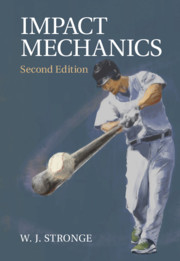3653 results in ebooks in fluid mechanics
12 - Impact of Sports Balls
-
- Book:
- Impact Mechanics
- Published online:
- 19 October 2018
- Print publication:
- 15 November 2018, pp 293-316
-
- Chapter
- Export citation
1 - Introduction to Analysis of Low-Speed Impact
-
- Book:
- Impact Mechanics
- Published online:
- 19 October 2018
- Print publication:
- 15 November 2018, pp 1-20
-
- Chapter
-
- You have access
- HTML
- Export citation
Acknowledgments
-
- Book:
- Impact Mechanics
- Published online:
- 19 October 2018
- Print publication:
- 15 November 2018, pp xvi-xvi
-
- Chapter
- Export citation
Appendix B - Glossary of Terms
-
- Book:
- Impact Mechanics
- Published online:
- 19 October 2018
- Print publication:
- 15 November 2018, pp 336-338
-
- Chapter
- Export citation
4 - Three-Dimensional Impact of Rough Rigid Bodies
-
- Book:
- Impact Mechanics
- Published online:
- 19 October 2018
- Print publication:
- 15 November 2018, pp 65-88
-
- Chapter
- Export citation
7 - Wave Propagation from Impact on Slender Deformable Bodies
-
- Book:
- Impact Mechanics
- Published online:
- 19 October 2018
- Print publication:
- 15 November 2018, pp 148-176
-
- Chapter
- Export citation
Dedication
-
- Book:
- Impact Mechanics
- Published online:
- 19 October 2018
- Print publication:
- 15 November 2018, pp v-vi
-
- Chapter
- Export citation
Copyright page
-
- Book:
- Impact Mechanics
- Published online:
- 19 October 2018
- Print publication:
- 15 November 2018, pp iv-iv
-
- Chapter
- Export citation

Impact Mechanics
-
- Published online:
- 19 October 2018
- Print publication:
- 15 November 2018
1 - Formulating Geodynamic Model Problems: Three Case Studies
-
- Book:
- Theoretical Mantle Dynamics
- Published online:
- 20 September 2018
- Print publication:
- 04 October 2018, pp 1-8
-
- Chapter
- Export citation
11 - Convection in More Realistic Systems
-
- Book:
- Theoretical Mantle Dynamics
- Published online:
- 20 September 2018
- Print publication:
- 04 October 2018, pp 219-240
-
- Chapter
- Export citation
Index
-
- Book:
- Theoretical Mantle Dynamics
- Published online:
- 20 September 2018
- Print publication:
- 04 October 2018, pp 310-314
-
- Chapter
- Export citation
Dedication
-
- Book:
- Theoretical Mantle Dynamics
- Published online:
- 20 September 2018
- Print publication:
- 04 October 2018, pp v-vi
-
- Chapter
- Export citation
Contents
-
- Book:
- Theoretical Mantle Dynamics
- Published online:
- 20 September 2018
- Print publication:
- 04 October 2018, pp vii-x
-
- Chapter
- Export citation
Preface
-
- Book:
- Theoretical Mantle Dynamics
- Published online:
- 20 September 2018
- Print publication:
- 04 October 2018, pp xi-xiv
-
- Chapter
- Export citation
12 - Solutions to Exercises
-
- Book:
- Theoretical Mantle Dynamics
- Published online:
- 20 September 2018
- Print publication:
- 04 October 2018, pp 241-291
-
- Chapter
- Export citation
3 - Self-Similarity and Intermediate Asymptotics
-
- Book:
- Theoretical Mantle Dynamics
- Published online:
- 20 September 2018
- Print publication:
- 04 October 2018, pp 22-32
-
- Chapter
- Export citation
frontmatter
-
- Book:
- Theoretical Mantle Dynamics
- Published online:
- 20 September 2018
- Print publication:
- 04 October 2018, pp i-iv
-
- Chapter
- Export citation
5 - Elasticity and Viscoelasticity
-
- Book:
- Theoretical Mantle Dynamics
- Published online:
- 20 September 2018
- Print publication:
- 04 October 2018, pp 86-95
-
- Chapter
- Export citation
Acknowledgements
-
- Book:
- Theoretical Mantle Dynamics
- Published online:
- 20 September 2018
- Print publication:
- 04 October 2018, pp xv-xv
-
- Chapter
- Export citation
